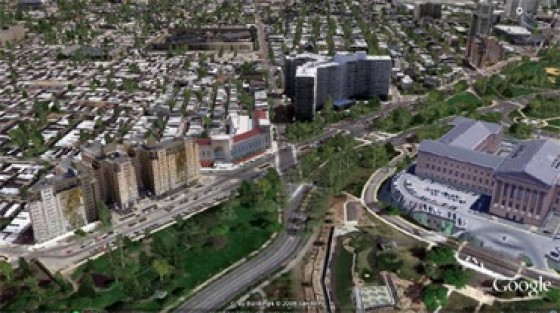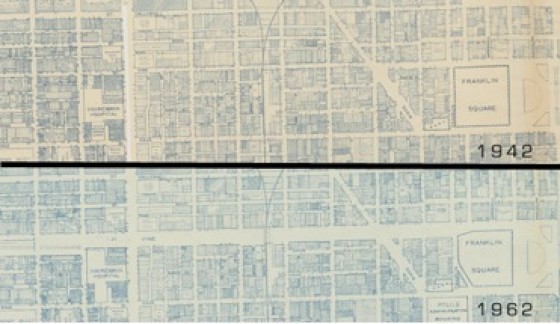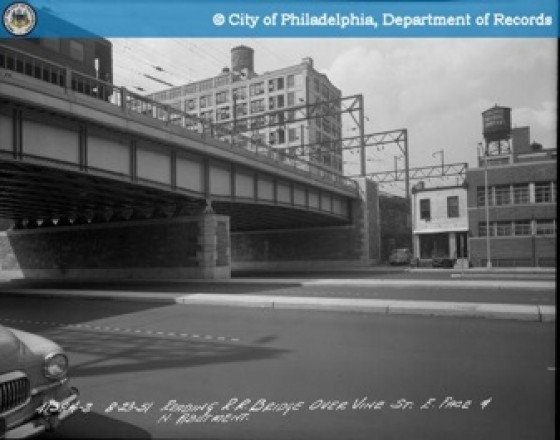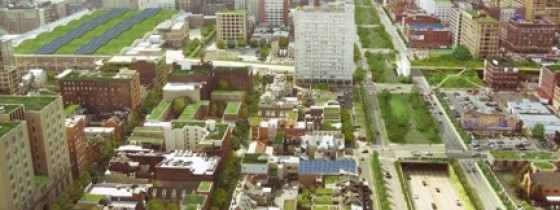People go nuts over the idea of the Reading Viaduct being turned into a park, why not double dip and cap 676 with a park that would connect the Viaduct and the Ben Franklin Parkway? We capped over the Pennsylvania Ave. Trench, why not 676?
The Vine Street Expressway, all 1.9 miles of it, took decades to get off the ground. After the completion of the Ben Franklin Bridge in 1926, all the traffic coming over the bridge from New Jersey was getting stuck on Vine St. A state highway was proposed that would have been very similar to the configuration used for Roosevelt Blvd., with a surface road with green space in the median and along the sides, but by the time it was being built in 1949-1951, the plan was down to a barebones 12-lane surface highway.
Only a few years later, planning for the sunken highway we all know and love began. The plan called for a short spur of highway called I-895 that would connect with the Schuylkill Expressway and reach out to 18th St. It was built by 1959, after its name changed twice and ended up as I-80S. As it was being built, plans were begun for an extension to the Ben Franklin Bridge.
The planning for the final stretch of the Vine Street Expressway was wrought with obstacles. Tunnels for the Broad Street Line and Broad-Ridge Spur subway tunnels presented a problem, as did the station for the Broad-Ridge Spur at 9th and Vine. Then there was the Reading Viaduct; the new bridge built for the state highway wasn’t going to work over the design they had for a sunken interstate highway. Finally, there was Franklin Square and what is now the PATCO tunnel.
It took 9 years to put together a plan. By the time it was finally being argued over in public hearings, the federal government had passed the Department of Transportation Act of 1966, part of which states that mowing down historic properties for a highway was no longer “cool.” This threw a massive wrench into the works considering that the plan called for the elimination of Franklin Square and an exit that led to 9th and Market that was going to take out a bunch of historic buildings. So back to the drawing board they went.
There was a new plan ready in 1971, but in 1973 the Federal Highway Administration decided that it should re-evaluate all highway plans for environmental impact, which would take an additional four years. By this point, the section up to 18th Street went through two more name changes and finally came to be called I-676. Arguments over new designs and some archeological digs went on for nine more years until Governor Bob Casey decided to just build the damn thing.
Final design changes included the connection with I-95 and the jog around Franklin Square. So much time had passed by the time it was built that the Reading Viaduct was no longer in use and was removed where it was in the way. After five long years of inconvenience for motorists and pedestrians, I-676 opened on January 10th, 1991.
Just because it opened doesn’t mean it was done. The shoulder between the bridge and the Broad Street exit was made into a traffic lane in 1999. In 2009, the first phase that reached 18th street had gotten so old it was about to crumble. It was replaced so quickly barely anyone noticed. Later construction may still take place… the Expressway does not meet the standards for Interstate Highways because of the section that jogs around Franklin Square. You’re not supposed to have traffic lights on an interstate. Who knew?
Soon after the sunken highway was complete, people noticed how much of a nuisance it was for everyone who wasn’t driving on it. A long hole cut across Center City isn’t really considered “urban-friendly,” or “nice,” as we say in the business. Its construction ruined otherwise horrible neighborhoods called the Furnished Room District and the Tenderloin, but also took a chunk out of Chinatown in the process. The 15th & Vine St. exit became one of the most dangerous intersections in the city for pedestrians. Buildings like the old School District HQ and the Boys Scouts HQ now sat adjacent to a huge hole. The Free Library and the Family Court became much noisier places. What could be done?
Proposals to cap over 676 have been floated in the past. A Chinatown group did a feasibility study in 2007 to cap over a single block segment. The Philadelphia Water Department’s Office of Watersheds came up with a capping 676 plan as part of a storm water management system.
When it comes down to it, no matter how much awesome we throw at it, the Vine Street Expressway will still be a giant interstate highway running through the northern boundary of Center City. That shouldn’t stop us from at least trying to solve the problem of a massive physical and psychological boundary between Center City and all points north. Remember, it’s doesn’t have to be a park. It could be anything. Think of the possibilities! Of course there will be staggering cost, serious engineering challenges, and the ever- present threat of NIMBYism. But considering how long it took to get the eyesore of a highway to get built in the first place, even if it takes fifty years to cap the thing, that doesn’t seem all that bad.
–GroJlart, philaphilia.blogspot.com






Leave a Reply